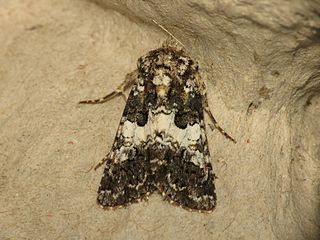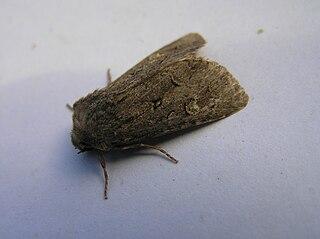| Resapamea | |
|---|---|
 | |
| Resapamea diluvius (male) | |
| Scientific classification | |
| Kingdom: | |
| Phylum: | |
| Class: | |
| Order: | |
| Family: | |
| Genus: | Resapamea Varga & Ronkay, 1992 |
| Species | |
See text | |
| Resapamea | |
|---|---|
 | |
| Resapamea diluvius (male) | |
| Scientific classification | |
| Kingdom: | |
| Phylum: | |
| Class: | |
| Order: | |
| Family: | |
| Genus: | Resapamea Varga & Ronkay, 1992 |
| Species | |
See text | |
The genus includes the following species:

Apamea is a genus of moths in the family Noctuidae first described by Ferdinand Ochsenheimer in 1816.

Agrotis is a genus of moths of the family Noctuidae. The genus was erected by Ferdinand Ochsenheimer in 1816. A number of the species of this genus are extinct.

Agrochola is a genus of moths of the family Noctuidae.

Conisania is a genus of moths of the family Noctuidae.

Cucullia is a genus of moths of the family Noctuidae.

Dasypolia is a genus of moths of the family Noctuidae.
Diarsia is a genus of moths of the family Noctuidae.

Drasteria is a genus of moths in the family Erebidae.

Hadena is a genus of moths of the family Noctuidae erected by Franz von Paula Schrank in 1802. About 15 species are native to North America, while over 100 are distributed in the Palearctic ecozone.
Hydraecia is a genus of moths of the family Noctuidae.
Lasionycta is a genus of moths of the family Noctuidae.

Luperina is a genus of moths of the family Noctuidae.
Mniotype is a genus of moths of the family Noctuidae.
Polymixis is a genus of moths of the family Noctuidae.

Pseudohadena is a genus of moths of the family Noctuidae.

Resapamea mammuthus is a moth in the family Noctuidae. It only known only from the type locality at Old Crow, Yukon Territory.

Resapamea hedeni is a moth in the family Noctuidae. It is found from southern Europe to Japan.

Anagnorisma is a genus of moths of the family Noctuidae.

Luperina dumerilii, or Dumeril's rustic, is a moth of the family Noctuidae. The species was first described by Philogène Auguste Joseph Duponchel in 1826. It is found in the Mediterranean region and warmer areas of central and south-eastern Europe. Strays have been recorded from southern England. It is also present in Turkey and Jordan.
| This Hadeninae-related article is a stub. You can help Wikipedia by expanding it. |